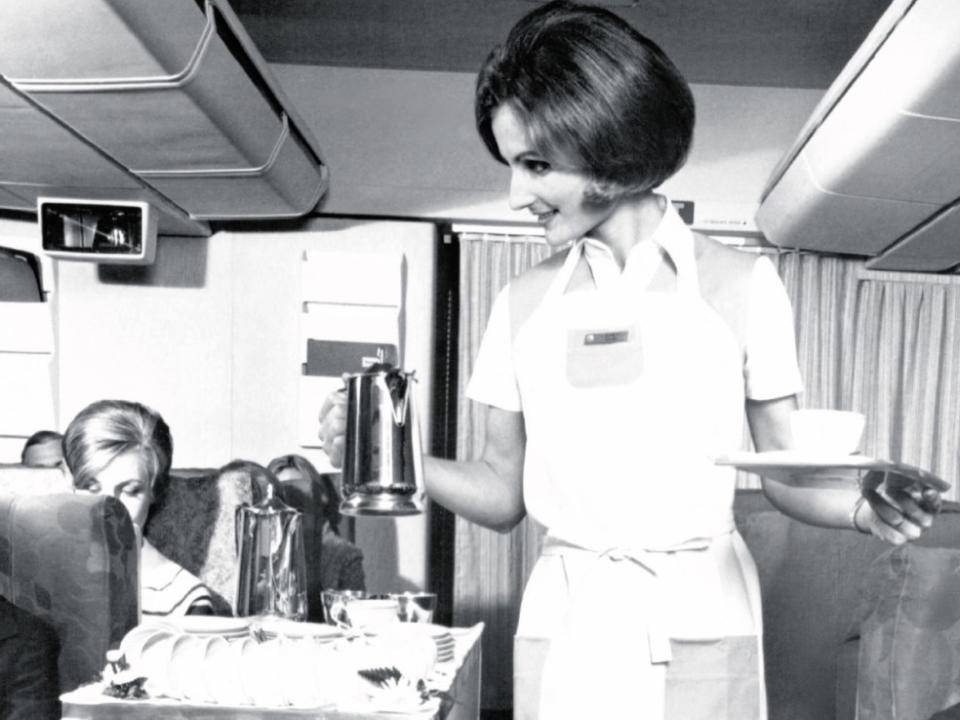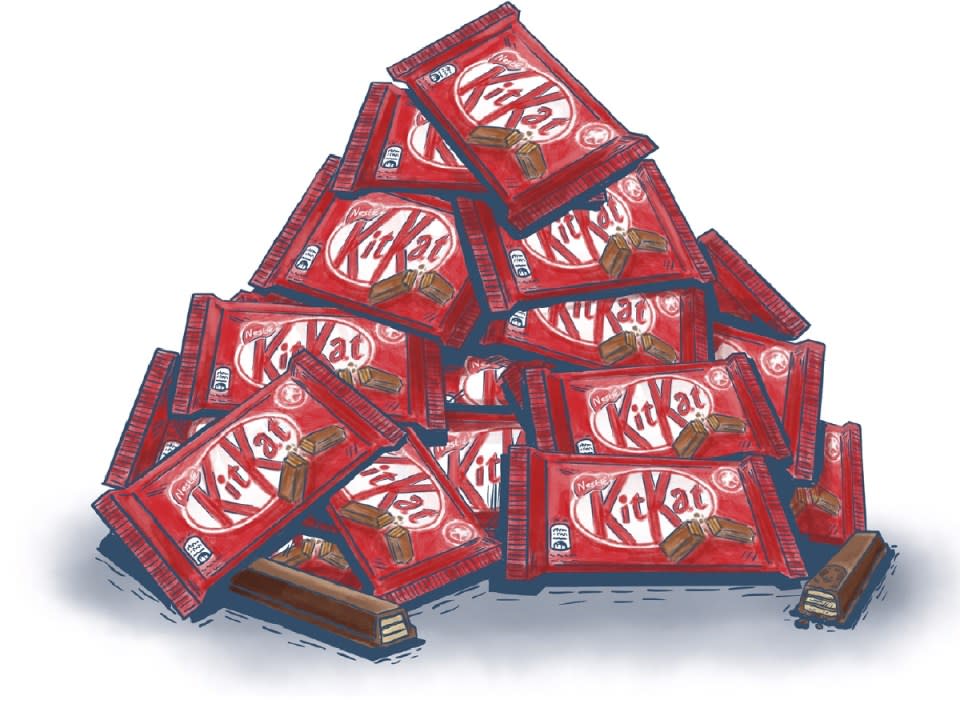Anatomy of a snack trolley: ‘Why is there always flapjack?’

Every time you go on holiday, it comes too. It’s there when you take a train from York to London, and – although it doesn’t have a passport – it makes its way from Stansted to Spain every day with ease. It is, in fact, on almost every British train track and runway; it’s the most well-travelled chocolate bar in (and above) the country. It’s the KitKat. Wherever there is a snack trolley, there is a KitKat, providing for peckish passengers and sticking two fingers up at the competition.
Who decided that this was the chocolate bar most palatable to the majority of the public? Snack trolleys aren’t sizable, and every bit of sweet and savoury has to fight for its place on a catering cart. Even if you’re only an occasional traveller, you’ve undoubtedly noticed some patterns: sticks of shortbread, slices of flapjack, posh packets of crisps and miniature cans of Pringles. Are these the nation’s favourites, or is something else going on behind the scenes? Who arbitrates the anatomy of a snack trolley, and how exactly do they do it?
Wherever there is a snack trolley, there is a KitKat, sticking two fingers up at the competition
“The choices that people make are safe,” says Zoe Farmer, global director of retail and management at Gate Group, a company that provides onboard catering to airlines such as Virgin Atlantic, Wizz Air, and Air Europa. Adventurous travellers are not necessarily adventurers eaters once onboard. Farmer says research and data has found that “the majority of people want something that they’re familiar with.”
Farmer’s colleague, global account director Kelly O’Reilly, is responsible for supplying complementary catering options on planes. Why is it that, more often than not, a flight attendant hands you a little packet of pretzels? “Pretzels are robust,” says O’Reilly, explaining that they’re also cost-effective and provide the perfect little side of salt when serving drinks. “I don’t know which came first – it’s like the chicken and the egg. Did the very small pack of pretzels come first or the demand from the airlines?”
Farmer and O’Reilly take a myriad of factors into account when stocking a plane with snacks. Space is king, of course – a delicious cookie might not work because it crumbles when stacked. There’s smell too – nothing should be too offensive in its odour. The pair also ensure that every product travels well – if they want to sell a new type of crisps, for example, they trial them on over 10 flights a day for a week to ensure the packets don’t pop. This is one of the reasons Pringles, in their sturdy cans, are so commonplace (the main reason, however, is simply that they’re popular all over Europe).

Mess is another factor; when flying from hotter destinations, the standard four-finger KitKat is replaced with a KitKat Chunky because it has a higher melting point. O’Reilly still rues the day she put popcorn on planes.
“Years and years ago, we had popcorn as a snack.” After the end of a two-week trial, O’Reilly heard from the team responsible for cleaning the planes, who have tight turnarounds to ensure aircraft are ready to fly again quickly. Popcorn, it turns out, gets absolutely everywhere. “Take it off,” the irate team demanded.
These days, the crew are often consulted before any new snacks come onboard – they may even get the final say if an airline is deciding between two new chocolate bars. Some airlines also have “instant reporting”, where flight attendants can tell Gate Group whether, say, a packet is too difficult to open.
On land, mess is less of a factor, says Jenna Chinery, onboard experience manager at Hull Trains (they sell popcorn). “We have wonderful onboard cleaning contractors,” she says, meaning she isn’t afraid to serve anything crumbly. Space is still crucial, though – Chinery says she wanted to stock Cup A Soup but found “they just don’t fit comfortably on our trolley”. Also a major consideration is a product’s origin. “The public responds wonderfully to a local supplier,” Chinery says – hence why you often see smaller crisps brands on trains. It’s also why Pullin’s fruit cake is “untouchable” on Great Western Railway, says a company spokesperson, because it “supports the communities we serve.”
Thanks to limited space, both planes and trains can’t afford to stock divisive snacks – a white chocolate bar or a pack of Twiglets, for example. This is why sandwiches on snack trolleys have fewer ingredients than you would see in the shops. “Every time you add an extra ingredient, the sandwich becomes more polarising,” Farmer says. A ham and cheese toastie is considered a safe bet.
“You always have to try and forget what you like personally and think of what the majority of the passenger demographic would like,” says O’Reilly (although Chinery, a cake fan, is looking for ways to get some onboard).
Stocking a snack trolley on a plane or train is a fairly risk-averse practice – one that’s about two years behind high street trends
Stocking a snack trolley, then, is a fairly risk-averse practice – O’Reilly says onboard catering is “about two years behind” high street trends. Still, most planes and trains will switch up their offerings two or three times a year, which helps them respond to demand. A decade ago, O’Reilly explains, healthy options would barely sell – today, customers are far more health-conscious and may choose a protein ball over a chocolate bar. There are limits on the nation’s need for nutrients, though. “Fresh fruit,” O’Reilly says, “sadly is not commercially viable as the demand for the product is very low.”
So what makes the ideal snack trolley? Farmer notes that products have to be varied enough to not encroach on each other’s sales, hence why you don’t get loads of different chocolate bars. Shortbread is popular on trains because it is familiar and expected. It’s also ideal for planes because it doesn’t “bloom” with a white coating like chocolate does when it changes temperature. Rob Taylor, food and beverage development lead at Avanti West Coast, explains that flapjacks are so commonplace because they’re “a good all-day product” – suitable for breakfast, lunch and dinner. He adds that flapjacks also “tick many boxes for dietary needs”, as they can easily be both gluten-free and vegan-friendly.
Complementary snacks can sometimes be more exciting, because handing them out means you don’t have to guess how many will sell. The reason you might get a mini ice-cream halfway through your long haul flight, O’Reilly explains, is because “snacking in a complimentary environment also meets a need to give passengers something to do.”
And what about the ubiquitous KitKat? “There’s a reason why KitKats are on nearly every plane,” says Farmer – and it’s not because they’re compact, although that certainly helps. Quite simply, “it’s one of the most popular products across Europe” – in the UK alone, more than one billion are eaten every year. She says it helps that KitKats aren’t crushed when you stack them on top of each other, but Chinery offers an even simpler explanation for why Brits in particular favour the snack on their travels. “It’s great to snap and dunk into a tea and coffee, isn’t it?”

 Yahoo Finance
Yahoo Finance 